
Project
Topic: “The Seven Wonders of the ancient world and nowadays”
Student: Guseynova Esmira
Form: 7a
Yaroslavl
2012
In this issue we present the first of three stories about some of the most interesting, beautiful and unusual places on Earth. We begin with a list of what have been called the Seven Wonders of the Ancient World.
People have always felt the need to create lists. Lists are records of important ideas, places, events or people. About two thousand five hundred years ago a Greek historian named Herodotus is said to have made a list of what he thought were the greatest structures in the world. His list of places became known as the Seven Wonders of the Ancient World.
Herodotus only wrote about places he knew. He did not know much about Asia. North and South America were completely unknown. Six of these ancient places no longer exist. We can only guess what they really looked like. But here is the list of those seven ancient Wonders of the World.
We begin with one that existed in what is now Iraq. It was called the Hanging Gardens of Babylon. King Nebuchadnezzar the Second probably built the gardens about two thousand six hundred years ago. Ancient historians say they were a huge system of gardens with trees and flowers.
Also on this list is the Colossus of Rhodes. It was a huge bronze metal statue of the Greek sun god Helios. The Colossus was about thirty-seven meters tall. It was built near the harbor on the Greek island of Rhodes about two thousand three hundred years ago. This ancient statue was destroyed in an earthquake.
Next on our list is the statue of the Greek God Zeus in a temple at Olympia, Greece. It was the most famous statue in the ancient world. Records say it was about twelve meters tall and made of ivory and gold. An earthquake probably destroyed the temple. The statue was removed and later destroyed in a fire.
The Pharos of Alexandria was an ancient lighthouse. A fire burning on the top of the lighthouse made it easier for ships to find the great harbor of Alexandria, Egypt. Records say the lighthouse was about one hundred thirty meters tall. It stood for one thousand five hundred years before it was destroyed by an earthquake.
The Temple of Artemis at Ephesus is another ancient wonder of the world. It was built to honor a Greek goddess. It was one of the largest and most complex temples built in ancient times. The temple was built in what is now Turkey about two thousand five hundred years ago.
Number six on our list was also built in what is now Turkey. It was the Mausoleum of Halicarnassus. The huge marble burial place was built for King Mausolus of Caria. It was so famous that all large burial places, or tombs, became known as mausoleums. An earthquake destroyed the structure.
The last of the seven ancient wonders are the oldest. Yet they are the only ones that still exist today. They are the three Pyramids of Egypt, near the Nile River at Giza. The pyraminds were built about four thousand five hundred years ago as burial places for ancient kings. The largest is called the Great Pyramid. It is almost one hundred forty meters high. It covers an area of more than four hectares. The Greek historian Herodotus said more than one hundred thousand men worked for more than thirty years to build the Great Pyramid. The great pyramids of Egypt will probably continue to exist for many years to come.
Now we will tell about several other ancient wonders that still exist today. We cannot tell about all of the great structures built in ancient times. There are too many. However, if Herodotus had known about the Great Wall of China we feel sure he would have included it on his list of wonders of the world
The Great Wall was begun more than two thousand years ago. It was built to keep out invaders. It extends about six thousand seven hundred kilometers across northern China. Today, the Chinese government is working to repair parts of the wall and protect as much of it as possible. The Great Wall of China is one of the largest building projects ever attempted. It is also the only object built by people that can be seen from space.
One of the oldest structures ever built by people also belongs on a list of ancient wonders. It is a circle of huge stones on the Salisbury Plain in southwestern England. It is called Stonehenge. Experts believe work began on Stonehenge about five thousand years ago. It was added to and changed several times until it became the structure we see today. We know very little about Stonehenge. We do not even know how these huge stones were moved to the area.
Some experts believe the stones were cut from solid rock about three hundred eighty kilometers away in Wales. One of the huge stones weighs as much as forty-five tons. Experts say Stonehenge may have been built as some kind of ceremonial or religious structure. Much has been written about Stonehenge, but experts say they still are not sure what it was used for.
Another famous ancient structure is the Coliseum in Rome, Italy. It was built almost two thousand years ago. The ancient Roman sports center could hold fifty thousand people who gathered there to watch public events. Experts say it is one of the finest examples of Roman design and engineering.
The city of Machu Picchu in Peru should be on most lists, too. Experts say it includes some of the best stone work ever built. The ancient Inca people built Machu Picchu high in the Andes Mountains, northwest of the city of Cuzco. Machu Picchu is about thirteen square kilometers.
India is famous for its temples and buildings. The most famous is the Taj Mahal, considered one of the most beautiful buildings ever constructed. The fifth Mughal emperor, Shah Jahan, ordered it built in Agra in sixteen thirty-one. He built it as a burial place in memory of his wife.
The Taj Mahal has tiny colorful stones inlaid in white marble. The structure seems to change color during different times of the day and night. Experts say it is one of the most perfect buildings ever constructed. They say nothing could be added or taken away to improve the beautiful Taj Mahal.
Abu Simbel was built more than three thousand years ago. It is about two hundred eighty kilometers south of Aswan on the western bank of the Nile River.
It took an army of workmen and artists more than thirty years to cut the huge temple into the face of a rock mountain. In front of the main temple are four huge statues of Ramses the Second. Each statue is about twenty meters high. Nearby is another temple that honors his wife, Nefertari. It too is beautifully carved out of solid rock.
The Nile River has always made life possible in the desert areas of Egypt. However the Nile also made life difficult when it flooded. The modern Egyptian government decided a dam could control the Nile to prevent both floods and lack of water. Work began on the Aswan Dam in nineteen sixty.
However, when plans were made for the dam experts quickly discovered that the great temples at Abu Simbel would be forever lost. They would be under water in the new lake formed by the dam. Egypt appealed to the United Nations agency UNESCO for help. UNESCO appealed to the world.
The governments of the world provided technical help and financial aid to save the great temples. In nineteen sixty-four work began to cut the temples away from the rock mountain. Each large piece was moved sixty meters up the mountain to a safe area. Then the huge temples were carefully rebuilt. The work was finished in nineteen sixty-eight.
Today Abu Simbel is safe. It looks much the same as it has for the past three thousand years. It will continue to honor the ancient king and his queen for many years to come. And it will honor the modern world's efforts to save a truly great work of art.
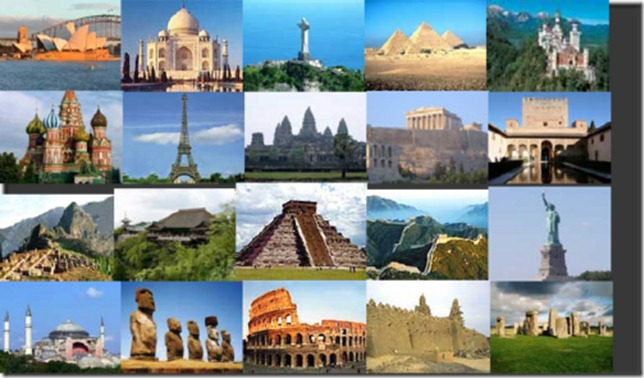
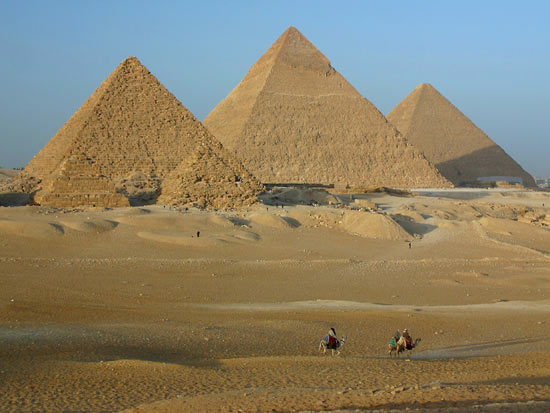
The Great Pyramid of Giza
It is the one and only Ancient Wonder which does not require a description by early historians and poets. It is the one and only Ancient Wonder that does not need speculations concerning its appearance, size, and shape. It is the oldest, yet it is the only surviving of the Seven Ancient Wonders. It is the Great Pyramid of Giza.
The Hanging Gardens of Babylon
Some stories indicate the Hanging Gardens towered hundreds of feet into the air, but archaeological explorations indicate a more modest, but still impressive, height.
The Statue of Zeus at Olympia
This is a statue of the God in whose honor the Ancient Olympic Games were held. It was located on the land that gave its very name to the Olympics. At the time of the games, wars stopped, and athletes came from Asia Minor, Syria, Egypt, and Sicily to celebrate the Olympics and to worship their king of Gods: Zeus.
The Colossus of Rhodes
The island of Rhodes was an important economic centre in the ancient world. It is located off the southwestern tip of Asia Minor where the Aegean Sea meets the Mediterranean. The capitol city, also named Rhodes, was built in 408 B.C
The Temple of Artemis at Ephesus
Eight hundred years after its destruction, the magnificent Temple of Artemis at Ephesus, one of the Seven Wonders of the Ancient World, had been completely forgotten by the people of the town that had once held it in such pride.
The Mausoleum at Halicarnassus
The Mausoleum at Halicarnassus is the burial place of an ancient king. Yet the Mausoleum is different - so different from the Pyramid that it earned its reputation - and a spot within the list - for other reasons. Geographically, it is closer to the Temple of Artemis... And it was the beauty of the tomb rather than its size that fascinated its visitors for years.
The Pharos of Alexandria (The Lighthouse of Alexandria)
Of the Seven Wonders of the Ancient World, only one had a practical use in addition to its architectural elegance: The Lighthouse of Alexandria. For sailors, it ensured a safe return to the Great Harbor. For architects, it meant even more: it was the tallest building on Earth. And for scientists, it was the mysterious mirror that fascinated them most... The mirror which reflection could be seen more than 50 km (35 miles) off-shore.
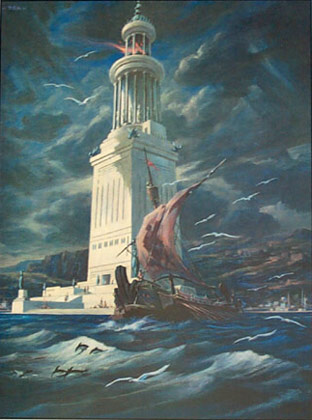
The Hanging Gardens of Babylon
Some stories indicate the Hanging Gardens towered hundreds of feet into the air, but archaeological explorations indicate a more modest, but still impressive, height.
The city of Babylon, under King Nebuchadnezzar II, must have been a wonder to the ancient traveler's eyes. "In addition to its size," wrote Herodotus, a Greek historian in 450 BC, "Babylon surpasses in splendor any city in the known world."
Herodotus claimed the outer walls were 56 miles in length, 80 feet thick and 320 feet high. Wide enough, he said, to allow two four-horse chariots to pass each other. The city also had inner walls which were "not as thick as the first, but hardly less strong." Inside these double walls were fortresses and temples containing immense statues of solid gold. Rising above the city was the famous Tower of Babel, a temple to the god Marduk that seemed to reach to the heavens.
While archaeological excavations have disputed some of Herodotus's claims (the outer walls seem to be only 10 miles long and not nearly as high) his narrative does give us a sense of how awesome the features of the city appeared to those ancients that visited it. Strangely, however, one of the city's most spectacular sites is not even mentioned by Herodotus: The Hanging Gardens of Babylon, one of the Seven Wonders of the Ancient World.
Gift for A Homesick Wife
Accounts indicate that the garden was built by King Nebuchadnezzar, who ruled the city for 43 years starting in 605 BC (There is an alternative story that the gardens were built by the Assyrian Queen Semiramis during her five year reign starting in 810 BC). This was the height of the city's power and influence and King Nebuchadnezzar is known to have constructed an astonishing array of temples, streets, palaces and walls.
According to accounts, the gardens were built to cheer up Nebuchadnezzar's homesick wife, Amyitis. Amyitis, daughter of the king of the Medes, was married to Nebuchadnezzar to create an alliance between the two nations. The land she came from, though, was green, rugged and mountainous, and she found the flat, sun-baked terrain of Mesopotamia depressing. The king decided to relieve her depression by recreating her homeland through the building of an artificial mountain with rooftop gardens.
The Hanging Gardens probably did not really "hang" in the sense of being suspended from cables or ropes. The name comes from an inexact translation of the Greek word kremastos, or the Latin word pensilis, which means not just "hanging", but "overhanging" as in the case of a terrace or balcony.
The Greek geographer Strabo, who described the gardens in first century BC, wrote, "It consists of vaulted terraces raised one above another, and resting upon cube-shaped pillars. These are hollow and filled with earth to allow trees of the largest size to be planted. The pillars, the vaults, and terraces are constructed of baked brick and asphalt."
"The ascent to the highest story is by stairs, and at their side are water engines, by means of which persons, appointed expressly for the purpose, are continually employed in raising water from the Euphrates into the garden."
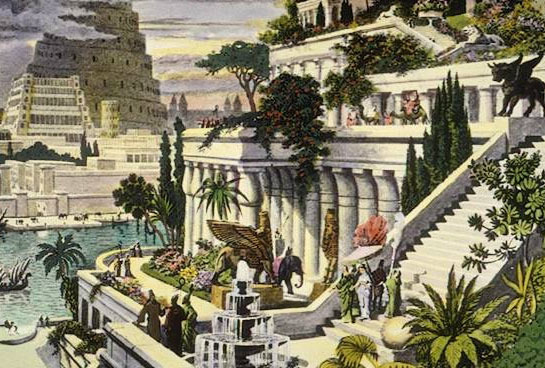
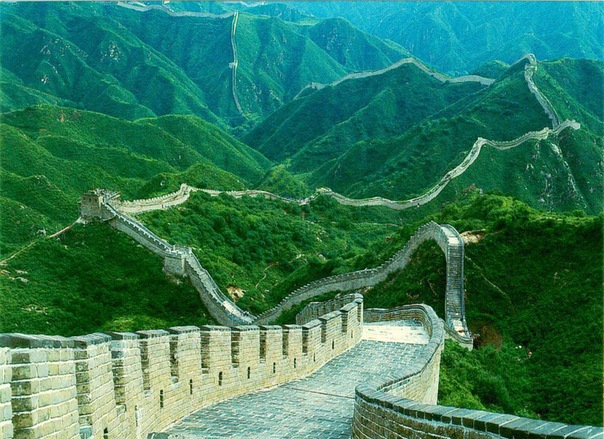
The Great Wall of China
The Great Wall of China, one of the greatest wonders of the world, was listed as a World Heritage by UNESCO in 1987. Just like a gigantic dragon, the Great Wall winds up and down across deserts, grasslands, mountains and plateaus, stretching approximately 8,851.8 kilometers (5,500 miles) from east to west of China. With a history of more than 2000 years, some of the sections are now in ruins or have disappeared. However, it is still one of the most appealing attractions all around the world owing to its architectural grandeur and historical significance.
The Great Wall of China, the most significant structure in the world, is the symbol of Chinese nation. Since the first built in Qin dynasty over 2000 years ago and many reconstructions during the history, the Great Wall had been playing important roles in defense of China over northern enemies. Locals like to call this structure as Wan Li Changcheng in Chinese language which means the Great Wall of 10,000 Li (one Li equals to half kilometers). Built with stone and block on the top of mountains, the Great Wall of China symbolizes the wisdom and power of Chinese people.
Located at Huai-rou County, 73 km northeast of Beijing, Mutianyu Great Wall is one of the best preserved walls built in Ming Dynasty (1368-1644). This section of the Great Wall is connected with Juyongguan Pass in the west and Gubeikou Gateway in the east. Like other sections of the Great Wall nearby, it used to serve as the defensive barrier for the capital and imperial tombs.
First built in the mid-6th century during Southern and Northern Dynasty (420-589), Mutianyu Great Wall was put under heavy reconstruction in the Ming dynasty by the famous Ming General Xu Da. In 1404, a pass was built here. In 1569, another General Qi Ji-guang ordered to reinforce the walls, even until today most parts of it are well preserved.
Whatever you may think of the Great Wall of China, it is an incredible feat of engineering.
With hundreds of thousands of men constructing thousands of miles of wall over the centuries, it is astounding to comprehend the history and events that took place over its lifetime.
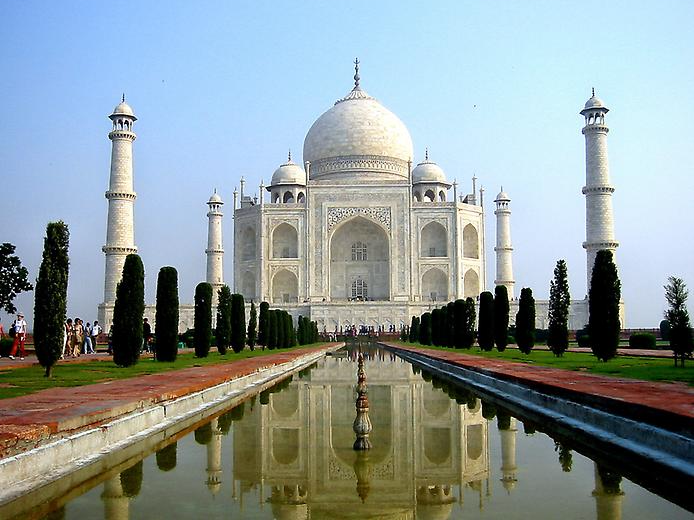 Taj
mahal
Taj
mahal
At the brink of dawn when the first rays of the sun hits the dome of this epic monument, it radiates like a heavenly abode, cloaked in bright golden. And then at dusk, basking in the glory of moon, it shines like a perfectly carved diamond; appearing as if straight out of some magical tale, leaving the viewers awestruck by its sense of grandeur. Nothing short of an architectural marvel, no wonder it stands proud at being one of the Seven Wonders of the World. And the rich beauty of this visual spectacle turns visceral when one hears the story behind it. The story of Taj Mahal!
Taj Mahal of India - "the epitome of love", "a monument of immeasurable beauty". The beauty of this magnificent monument is such that it is beyond the scope of words. The thoughts that come into the mind while watching the Taj Mahal of Agra is not just its phenomenal beauty, but the immense love which was the reason behind its construction. Mughal Emperor Shah Jahan got this monument constructed in the memory of his beloved wife Mumtaz Mahal, with whom he fell in love at the first sight. Ironically, the very first sight of the Taj Mahal, the epitome of love and romance, also leaves visitors mesmerized and perpetually enthralled.
Standing majestically on the banks of River Yamuna, the Taj Mahal is synonymous to love and romance. It is believed that the name "Taj Mahal" was derived from the name of Shah Jahan's wife, Mumtaz Mahal and means "Crown Palace". The purity of the white marble, the exquisite ornamentation, precious gemstones used and its picturesque location, all make a visit to the Taj Mahal gain a place amongst the most sought-after tours in the world. However, until you know the love story behind the construction of the Taj Mahal, the beauty of the same would not enliven in your heart and mind and instead would come up as just another beautiful building/monument. It is the love behind this outstanding monument that has given a life to this monument. Come and explore the visceral charisma that it emanates!
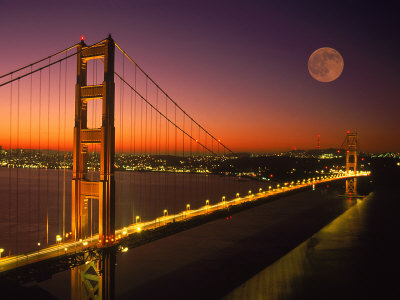
The golden gate bridge
The Golden Gate Bridge in San Francisco, California is one of the most beautiful, and most photographed, bridges in the world.
Fort Point is an historic Civil War era masonry building partially under the south end of the massive bridge.
Linking San Francisco with Marin County the Golden Gate Bridge is a 1.7 mile-long suspension bridge that can be crossed by car, on bicycles or on foot
There are parking and viewing areas at either end of the bridge.
The Marin Headlands side of San Francisco's GGB is a great place to take pictures—such as this July 4th fireworks photo or the panorama just below it—and watch freighters and sailboats cruise under the bridge.
The Golden Gate Bridge design echoes an Art Deco Theme. Wide, vertical ribbing on the horizontal tower bracing accents the sun's light on the bridge.
The towers that support the Golden Gate Bridge's suspension cables are smaller at the top than at the base, emphasizing the tower height of 500 feet above the roadway. Irving Morrow—an architect hired by Strauss to design an architectural treatment for the bridge—chose the ‘international orange’ paint color to blend with the setting while still being very visible to ships.
Coit Tower is another San Francisco landmark with an Art Deco design. Timothy Pflueger was probably the most prolific and renowned Art Deco Architect in the San Francisco Bay Area.
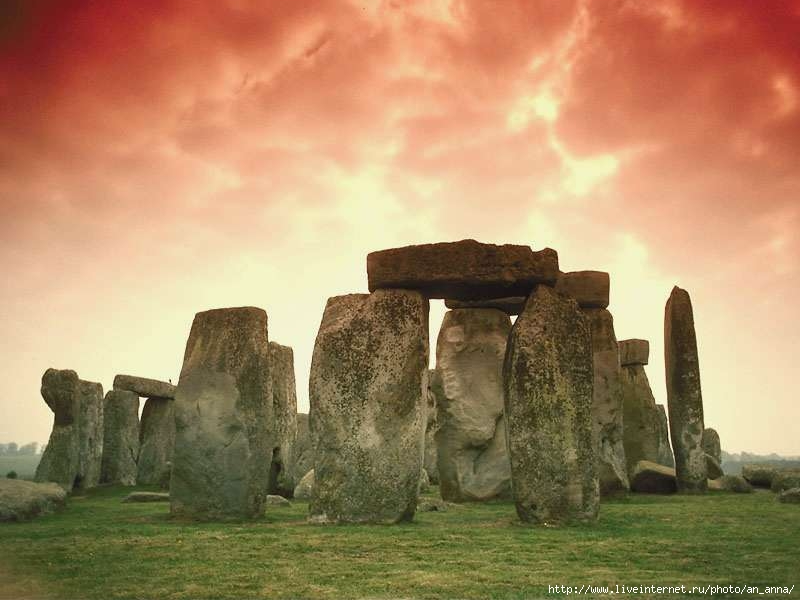
Stonehenge
Stonehenge is a prehistoric megalithic monument in county Wiltshire in England. The large stone circle is predated by a surrounding ditch and bank earthworks. The site is owned by the Crown and managed by English Heritage, a public body which maintains England's ancient monuments. The surrounding land is owned by the National Trust, the conservation organization which works "to preserve and protect the coastline, countryside, and buildings of England, Wales, and Northern Ireland."
As large as the rocks are, it is hard to imagine how prehistoric man could have built Stonehenge. It has been suggested that some supernatural force was responsible, but conventional methods available in those ancient times have been proven to be capable of moving such stones.
Stonehenge was built before written language, so there is no record of the haws and whys of the structure. We can only speculate as to the purpose of the site. Some theories are that it was used as a calendar, an astronomical observatory, a religious site, a burial site, or a place of healing.
Of course, the main function of Stonehenge today is attracting tourists. It was roped off in 1977 to avoid erosion and damage by vandalism. Access to the stones is permitted, though, during summer and winter solstice and spring and autumn equinox, as well as other times by pre-arrangement.
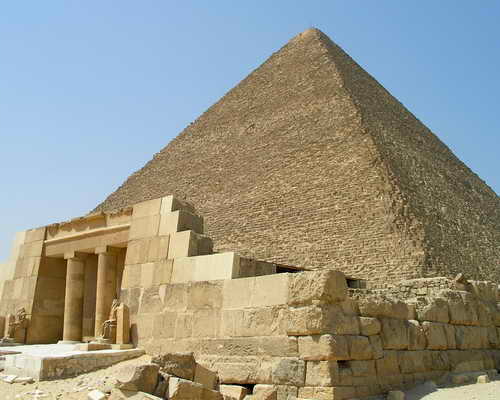
Great Pyramid of Giza
The pyramids of Giza are the only surviving Ancient Wonder of the World and one of the most famous tourist attractions in the modern world. They are some of the oldest sacred sites in our index and certainly among of the most impressive. (The Great Sphinx of Giza has a separate article.)
Although it is clear the pyramids were used for the burial of pharaohs, the construction, date, and possible symbolism of the Giza pyramids are still not entirely understood.
This mystery only adds to the attractiveness of these ancient wonders and many modern people still regard Giza as a spiritual place. A number of fascinating theories have been offered to explain the "mystery of the pyramids," one of which is summarized below.
Giza is the most important site on earth for many New Age followers, who are drawn by the pyramids' mysteries and ancient origins. Since 1990, private groups have been allowed into the Great Pyramid, and the majority of these have been seekers of the mystical aspects of the site. But even the most skeptical visitor cannot help but be awed by the great age, grand scale and harmonic mathematics of the pyramids of Giza.
The question of how the pyramids were built has not yet found a definitive answer. Herodotus reported that the base was laid, then the great blocks (each weighing about seven tons) were levered into place, a step at a time up all 203 steps. But this cannot be done, as demonstrated by a Japanese attempt at a duplicate in the 1980s. The most plausible explanation is that the Egyptians employed a sloping and encircling embankment of brick, earth, and sand, which was increased in height and in length as the pyramid rose; stone blocks were hauled up the ramp by means of sledges, rollers, and levers.
The pyramids have impressively withstood the ravages of time, but not of grave robbers. They emptied the pyramids of their valuables in ancient times. In 1818 an Italian entered the burial chamber of Khafre with a hydraulic ram, but the gold and other treasures were long gone.
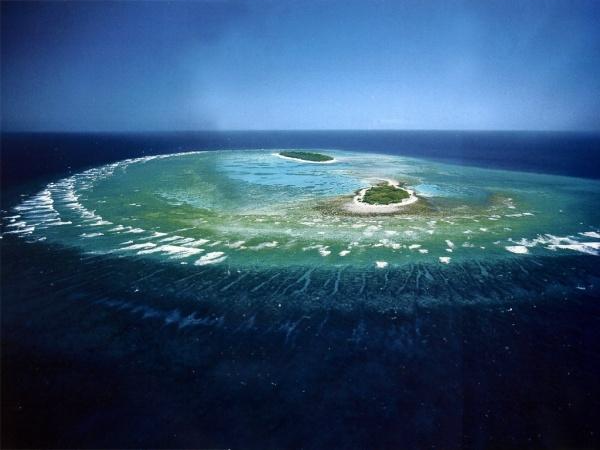

Great Barrier Reef
One of Australia's most remarkable natural gifts, the Great Barrier Reef is blessed with the breathtaking beauty of the world's largest coral reef. The reef contains an abundance of marine life and comprises of over 3000 individual reef systems and coral cays and literally hundreds of picturesque tropical islands with some of the world’s most beautiful sun-soaked, golden beaches.
The Great Barrier Reef is one of the seven wonders of the natural world, and pulling away from it, and viewing it from a greater distance, you can understand why. It is larger than the Great Wall of China and the only living thing on earth visible from space.
It is the largest reef in the world and consists of nearly 3000 individual reefs, 880 islands and hundreds and thousands of different types of plant, bird and marine life. Swimming with the fish and admiring the colors of the coral is a must for any holiday to the Great Barrier Reef. Outer reef scuba diving and island day trips are some of the more common pastimes on the reef along with scenic flights and rainforest tours to Kuranda and the Daintree Rainforest.
The Great Barrier Reef Visitors Bureau has a comprehensive selection of support information for the use of the intending traveler. This section contains, maps and weather information, and links to other holiday destinations like Port Douglas accommodation.
The Great Barrier Reef, and in particular the northern sector, is important in the historic and contemporary culture of the Aboriginal and Torres Strait Islander groups of the coastal areas of north-east Australia. This contemporary use of and association with the Marine Park plays an important role in the maintenance of their cultures and there is a strong spiritual connection with the ocean and its inhabitants.
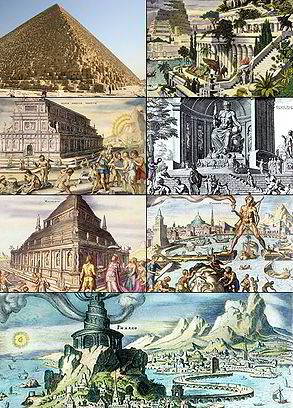
We looked at all the wonders of ancient world and our time. In many respects they are identical because humanity is trying to keep the entire natural, built and erected such as a construct beauty and natural beauty.
